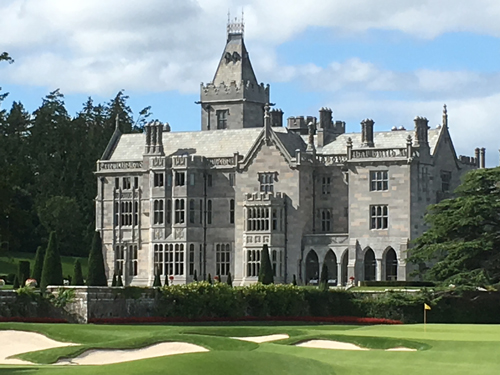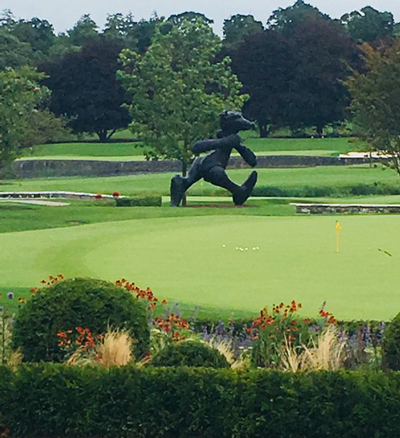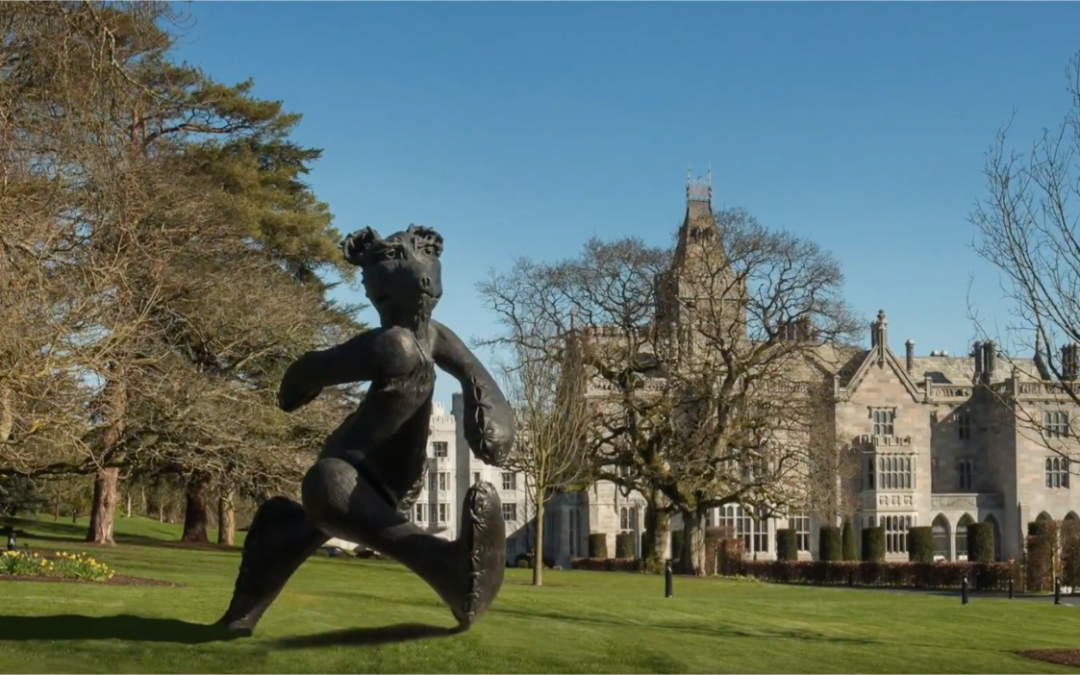
The Bear of Adare
The visionary, Limerick-born businessman, J.P. McManus completed the purchase of the five-star Adare Manor property in December 2014. Just over one year later, it closed for a full twenty-one months to complete a major refurbishment and expansion, which included more than forty new bedrooms and an elegant Grand Ballroom. The new wing, constructed sympathetically with grey limestone, blends seamlessly with the stately older building.
Originally a two-story manor house from the early 18th century, it was passed to the second Earl of Dunraven in 1832. He then set out rebuilding it in the Tudor-Revival style. When it was purchased in 1987 by Americans Tom and Judy Kane, they restored and expanded it into a 62-bedroom five-star hotel and in 1995 added a highly-rated golf course, designed by the legendary Robert Trent Jones, Sr. To match the luxurious interior upgrades, world renown golf course architect, Tom Fazio, was hired to bring his expertise to re-imagining the iconic layout.

Before buying the resort, McManus had a long association with Adare Manor, where he hosted the famous Pro-Am golf tournament in 2005 and 2010, raising millions for charity. Golf superstars included Tiger Woods, Adam Scott, Fred Couples and Padraig Harrington, along with numerous celebrities like actors Michael Douglas and Hugh Grant.
One can’t introduce the monumental “Bear of Adare” without mentioning the golf component of the resort, because the permanent home for this, the largest figurative bronze ever created in Ireland, is within view of the dining room of the golf clubhouse.
The giant teddy bear, titled “Marching On,” stands just over 13 feet tall and was produced by renown Irish artist Patrick O’Reilly. About his work, O’Reilly said:
“From childhood days our first memory is that of a bear. He personifies innocence, companionship and trust. He is a pure spirit and symbolises unworldliness. As adults many of us remember this childhood time with a reverence, as sadly this era must end. Life must take its course and is never stationary.
“The Bear marches on with a look of resigned acceptance. He keeps going despite life’s turbulence and uncertainty. He is silent and does not complain.”
There are many wondrous things in Ireland, starting with the Cliffs of Moher, close to where I spend my summers in County Clare, and I am now adding this magical bronze sculpture to my ever-growing list.
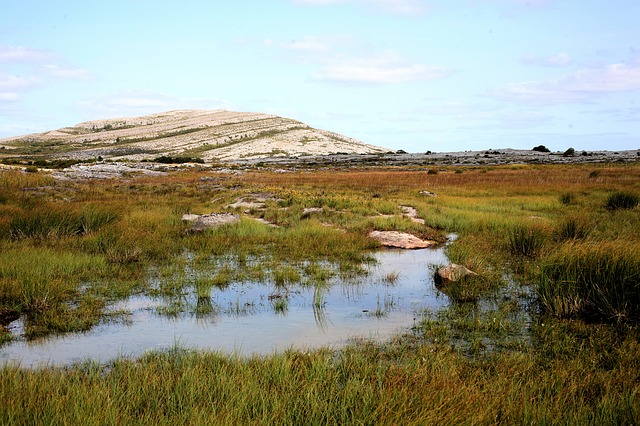
Life Across the Pond

Tony Kirby
A better introduction and guide to the west of Ireland, you will never find anywhere. Photo by Taba Dale.
You will never know the beauty or the deeper heritage of the west of County Clare like you will if you go on a Burren Walk with Tony Kirby. Tony is originally from Limerick and after working in Dublin and Italy, he settled in County Clare. He is now a full-time walking guide and heritage consultant, based in the Burren.
One thing you would probably never expect, is to hear a W.B.Yeats (1865-1939) poem while on your walk. However, when we reached a magical rainforest (yes, in the Burren!), Tony stopped to explain the importance of what he defined as a “magisterial woodland.” When a lady in our group said, “You should quote ‘I walked into a hazel wood’,” Tony replied, “I’ll do a William Butler Yeats poem for you, Ann, but this one is very short. It’s called ‘Politics’ and to give you the context, when he wrote it, there is a war looming in the world and also, he is an aging gentleman.”
And then he recited:
How can I, that girl standing there,
My attention fix
On Roman or on Russian
Or on Spanish politics,
Yet here’s a travelled man that knows
What he talks about,
And there’s a politician
That has both read and thought,
And maybe what they say is true
Of war and war’s alarms,
But O that I were young again
And held her in my arms.
– W. B. Yeats, “Politics” from Last Poems (1938-1939)
Then of course later on, after the guided walk, I had to look up the one Ann asked Tony to recite. It is quite a bit longer and sublime. It is called ‘The Song of Wandering Aengus’ and here it is:
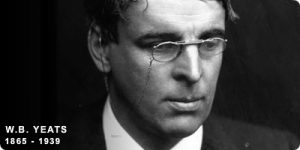
I went out to the hazel wood,
Because a fire was in my head,
And cut and peeled a hazel wand,
And hooked a berry to a thread;
And when white moths were on the wing,
And moth-like stars were flickering out,
I dropped the berry in a stream
And caught a little silver trout.
When I had laid it on the floor
I went to blow the fire a-flame,
But something rustled on the floor,
And someone called me by my name:
It had become a glimmering girl
With apple blossom in her hair
Who called me by my name and ran
And faded through the brightening air.
Though I am old with wandering
Through hollow lands and hilly lands,
I will find out where she has gone,
And kiss her lips and take her hands;
And walk among long dappled grass,
And pluck till time and times are done,
The silver apples of the moon,
The golden apples of the sun.
But then, it seems just as important to include the Nobel laureate, Seamus Heaney (1939-2013) in this story. Here is ‘Postscript’ from his book The Spirit Level: Poems:
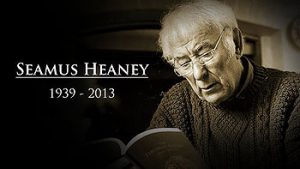
And some time make the time to drive out west
Into County Clare, along the Flaggy Shore,
In September or October, when the wind
And the light are working off each other
So that the ocean on one side is wild
With foam and glitter, and inland among stones
The surface of a slate-grey lake is lit
By the earthed lightening of flock of swans,
Their feathers roughed and ruffling, white on white,
Their fully-grown headstrong-looking heads
Tucked or cresting or busy underwater.
Useless to think you’ll park or capture it
More thoroughly. You are neither here nor there,
A hurry through which known and strange things pass
As big soft buffetings come at the car sideways
And catch the heart off guard and blow it open.
When you read these words and picture Clare, or the Burren, or better yet, come over here yourself, you will begin to absorb the essence of Ireland. And in ten more lifetimes, you can find the wisdom in the soul of Ireland. But if you spend just one afternoon with Tony Kirby, you will shorten the number of lifetimes by a good few.
William Butler Yeats was awarded the Nobel Prize in Literature in 1923. He renovated an old tower house near the town of Gort in County Galway and named it Thoor Ballylee, Thoor being the Irish word for tower. From 1921 to 1929, Yeats and his family lived there so Yeats could be close to the beauty of the countryside and also be near his close friend, the writer, folklorist and playwright, Lady Augusta Gregory. With Lady Gregory and another neighbor, Edward Martyn who lived at Tullira Castle, they formed the Irish Literary Theatre in 1899. Then, in 1904, they became the co-founders of the Abbey Theatre.
From the top of the tower house, one can see views of the south of Galway, stretching all the way to the Burren. And should you be inclined to get a copy of Tony’s book, The Burren & The Aran Islands, A Walking Guide, he includes a walk at Coole Park and begins Route 12 with this excerpt from the W.B. Yeats poem ‘The Wild Swans at Coole’ (1919):
“The bell-beat of their wings above my head
Trod with a lighter tread…”
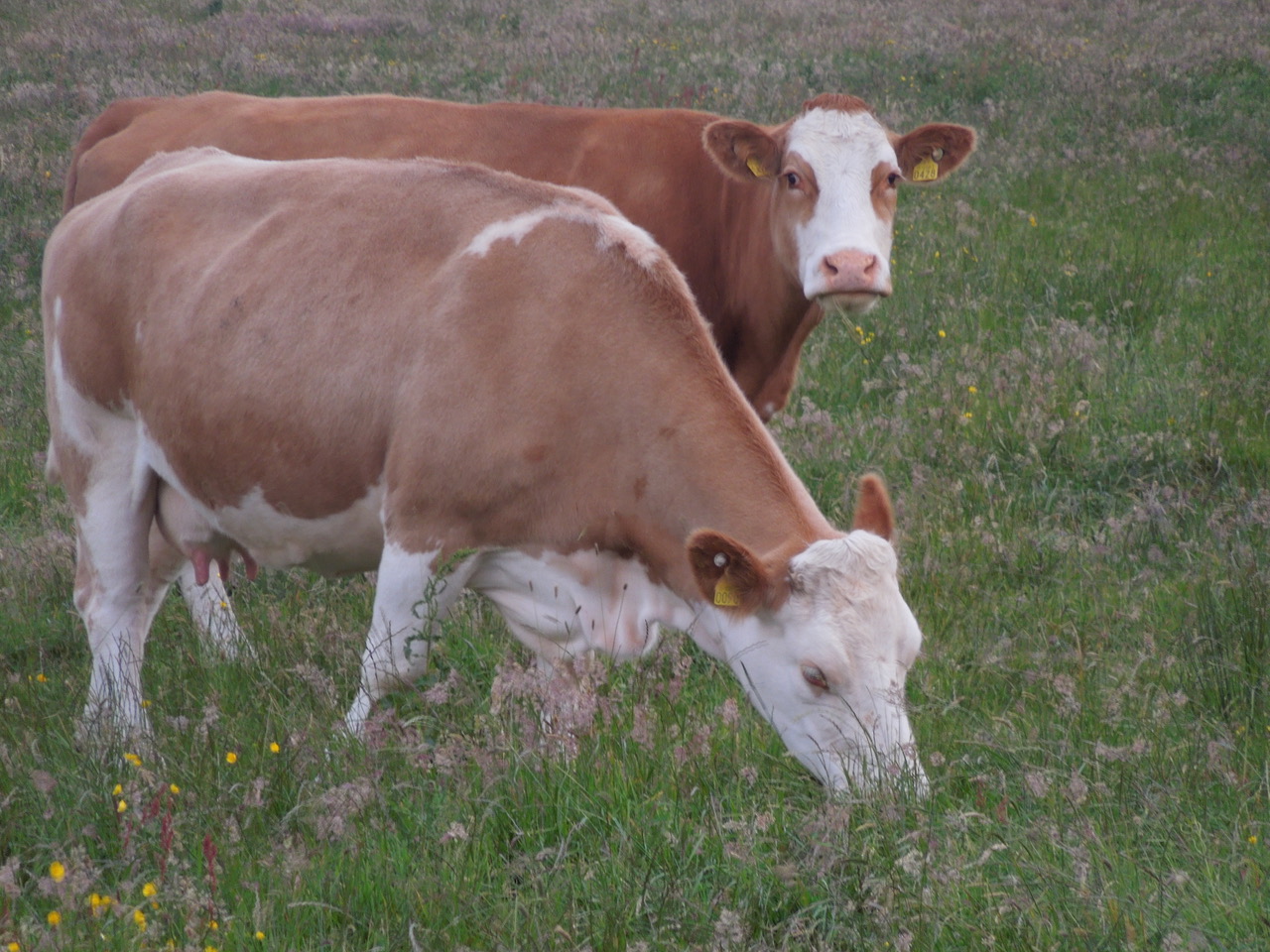
They’re All Shirleys
Upon returning to our house by the water’s edge in quaint Liscannor, I was happy to see the herd of contented cows romping around. Well, the new calves romp. The massive mothers, or dams, pick up their lazy stride only once in a great while.
As always, I scanned the herd for my darling Lucy and Elsie. Yes, gigantic as they are, they are still darling. I couldn’t quite spot them at first, but I did notice a couple of new girls—both with white faces.
Next stop: Computer: Google. I quickly deduced that we now have a Simmental cow and a Hereford cow in our herd based on the fact that those breeds are known for their white faces. I’d gone so far as to name one of them “Simmi,” due to perfectly matched coloring with the photos and descriptions of Simmentals described on various websites.
The other one I named “Goggles.” Along with her white face and roan coloring, she had big circles of reddish hair surrounding her eyes. No doubt about it. She’s a Hereford!
Two days later, Tommy Mantle pulled up with his bright red Mountfield ride-on mower to tidy up our lawn. He tows the 400-pound mower on his trusty trailer. But I didn’t realize he was here until I heard him cutting some weeds up against our stone wall with his string trimmer, or whatever they call a weed-wacker in County Clare. After that, he mounted the black driver’s seat, and commandeered the mower—actually a lawn tractor complete with a large rear-mounted grass cuttings collector— and began his regular pattern, following the large square perimeter of the expansive back yard.
His circles, or rather, his squares became smaller and smaller, until he mowed down the last daisies in the middle of the lawn. Funny how they call it a garden over here, even though all we have is just grass and buttercups. No flower boxes. No ornamental shrubbery. Just grass. That’s an Irish garden.
Tommy, clad in blue denim overalls with a few wisps of his greying blonde hair sticking out of his trademark white painter’s cap, emptied the grass clippings from the collector down by the Liscannor flagstone wall nearest the sea. This wall is relatively low, but wide enough to make climbing over it difficult, to say the least. I’ve heard Kevin say that having that wall of stacked flags built around the whole property cost as much as the land itself.
The pile is also just a yard from the hairy rock wall bordering our land and the pasture next door where “my” little herd of cows roamed. This way, Tommy could pitch most of the pile over the flagstone wall but also throw some clippings to the cows. The herd heard the mower and sniffed the fresh cut grass and were already moseying over to the wall.
Tommy cut the off engine and that was my signal to run outside to pepper him with questions about the cows.
After catching up on how was his winter, I said, “Tommy, we have some new cows this year — two with white faces. I wondered if one is a Simmental?”
“No,” he said, pointing to Simmi, “that’s a Shirley.”
“Are you sure?” I asked in surprise. “I read up on her and she looks just like a Simmental. They all have a white face. They come from Switzerland, I think.” I added the “I think” to underscore the fact that I am only a budding cowologist and regard Tommy as the absolute cow expert.
“She’s a Shirley,” Tommy affirmed with a smile.
I pointed to Goggles. “What about the other one with the white face and pigment around her eyes? She’s a Hereford, right?”
“No,” he shook his head said in his gentle voice, “she’s a Shirley too.”
How could this be? There was a distinct difference. Wasn’t there?
What the hell! They’re all Shirleys?
“Tommy, see that huge one out there? I call her Batty because she’s grey and as big as a battleship. Is she a Shirley too?”
With a twinkle in his eye behind his wire rim glasses he nodded, “Yes, she is.”
A Shirley is actually a Charolais. But Tommy calls them Shirley so Shirley they are. This type of continental cattle is thought to have originated in Charolles near the French region of Burgundy. They are often white or cream colored (like Elsie) but obviously they come in loads of colors, if our herd is all Shirleys.
Why, there is even a black calf but I haven’t worked out who the mother is yet.
Oh well, not to worry. At least now I know that what I have is nothin’ but Shirleys!

Moy or No Moy
The other night while having our customary romantic dinner by candlelight—we now have a proper candle-holder with one 3” wide x 4” tall candle-that-melts-inward, which replaces a rustic block of wood holding an “individually foil-cupped Kinsale-Candle Night Light for Every Occasion,” (in other words a wee tea light)—I looked over Kevin’s shoulder (as he gives me “the view” to the bay, and I asked, “What is that big white building on the other side of the bay? Is it just one house?”
To which he replied, “That is Moy House.”
We then talked about the fact that before he bought the lot our present house was built upon, Moy House was up for sale and he went to have a look with an idea to purchase it. It was so run-down, requiring many tens of thousands of Irish pounds, that he quickly abandoned the thought.
There it now stands, across the bay, registered in Ireland’s Blue Book of Irish Country Houses and Restaurants. It is described as having a “sensitive restoration of an early 19th century estate, creating a contemporary and eclectic ambience…with eight oversized rooms on 15 acres and commanding hilltop views over Lahinch Bay, enhanced by mature woodland and the meandering River Moy.” The book also says it has a “traditional Drawing Room and a Zen-feel lower Library area.” Sounds lovely.
Too bad I am not at all confident about driving Kevin’s car while he is away at Old Head—especially in the rain with the sort-of-intermittent wipers, or I’d go have a look.
Moy or no Moy really defines: is there a mist, a fog, or a downpour? Can I see Moy House or can I not? As the crow flies, it is probably only three miles away. Well, I can see it, but it is raining.
In fact, while it looked like it was not raining yet, I thought I would take a walk up to the gas station/shop to get some soup or something warm in time to watch The Scottish Open on TV over at Loch Lomond. I figured on bringing my good golf umbrella (a perfect souvenir from Turnberry) in case it started to rain on the way home. As I got out the front door, it was, in fact, already raining. It was gentle enough with no real wind. That is, until I got around the corner. All hands on deck! Man the sails! Two hands on the tiller!
I made it to the store and back with a microwavable container of Erin Soupfulls Chicken & Country Vegetable soup, nearly soaked-through jeans and Moy House now disappeared in the mist.
But I know it is there—and someday, I promise myself I’ll see it from the inside, while having a piping hot bowl of seafood chowder as I look back across the bay and see, or not see, our charming little white house on the water’s edge.

The following article was written by Taba Dale, and was published in The Clare Champion, a regional newspaper published in Ireland.
Ann takes her place on the Liscannor Strip
The Strip has a newcomer and oh what a star! She’s beautiful but not flashy. She’s charming in a way that people are when they are comfortable in their own skin. She’s funny without meaning to be. She’s talented, and for sure, she’s meaning to be.
No, it’s not Celine Dion. Not Britney Spears. It’s Ann Daly, the painter that has just opened a new art space called The Atlantic Way Gallery. Sandwiched in-between last year’s new headliner on The Strip—the bustling “Come In, We’re Awesome” bakery, and the stately 19th-century stone church.
The single story, nondescript building is set back from the road behind a carpark. A sign, now removed, used to say ‘Community Centre’.
Oddly enough, I learned later on, that when Ann’s mum came for her first visit to the new gallery, while drinking her Bailey’s coffee, she told Ann, “I used to go to school in this building, and now here you are!”
I bumbled in and discovered a room full of paintings, mostly of the sea, in all its many moods. I know its temperamental nature well because we live just steps away from Liscannor Bay. From dark and brooding to playful and shimmering, Ann’s works capture the sea and rocky west coast of Clare exquisitely.
There is quite a selection, ranging from large originals painted with a palette knife to masterfully rendered miniatures in many layers on primed wood. Tastefully matted prints, both framed and unframed, are attractively displayed.
“These look like they’re all done by one person. Are you the artist?” I asked the lovely brown-haired woman who was sweeping the floor beside a small white desk.
“Oh, sorry, we just put down this floor five weeks ago and I’m a bit precious about it. Yes, I am,” she answered quietly, almost in a whisper, not wanting to wake…what was under that blanket?
“Oh! It’s a dog! Oh! It’s two dogs!” I was surprised because they were not little dogs either.
One dog was brown and white speckled and absolutely gorgeous. “What kind of dog is that?”
“They are German Shorthaired Pointers,” Ann answered.
“Both of them?”
“Yes, actually they are rescue dogs,” Ann explained as she petted the more energetic one, whose name was Penny.
“She was in bits, this one. Nearly dead. We nursed her back to health and named her Penny, for when she came into my life, she was my Lucky Penny.”
Just then, a man I had seen a few minutes earlier, as I was about to enter the gallery, appeared inside. He had cheerfully said to me, “Thanks for coming,” which I found friendly and a bit strange at the same time, since he seemed to be leaving. Now I knew why. He was obviously connected to Ann. But not merely connected—married sixteen years this very month.
I learned that when I had commented on one picture, not just different because all the seascapes were in oil and this one was in watercolor, but because the subject matter was a complete departure. It was a painting of two young people kissing—a very sweet portrait of young love.
Ann told me that the image was, in fact, used as their wedding invitation. Upon asking how she met her husband-to-be, Ann, flashing her dazzling smile said, “We met at a music festival in Tipperary. Neither of us had any tickets and we didn’t see any music.”
When I was introduced to Ronan, who had a spectacular crown of thick, George Clooney-esque salt and pepper hair, I said, “Did you know the owner of the Cliffs of Moher Hotel (at the beginning of The Strip) is named Ronan and so is the owner of the woolen shop on the corner?”
To which he replied, “Ronan used to be such an uncommon name. It comes from the word “ron” and means “baby seal.”
Well, that’s a story in itself. Or rather a legend.
The dogs were getting frisky now, fully awake from their slumber.
Penny was jumping on Ann and the brown one came over to give me a sniff.
Ronan commented, “Look at that. That’s something she would never have done when we first got her…gone to people. Never. Tessy, good girl.”
Apparently that wasn’t the case when she was first adopted. In fact, Ann explained, “Tessy was so nervous, she used to jump at her own shadow.”
Still petting Tessy, I observed, “They both have short hair, but this one seems shorter.”
“She certainly is a purebred. We think she was a breeder,” Ronan replied with obvious pride.
By now I realized that Ronan’s pronunciation of certain words was slightly different and I ventured, “You sound like you have a Northern Ireland accent.”
He confirmed, “I’m from Belfast originally. When I was living there before I moved, I could tell the difference in various parts of Belfast—nearly every five or ten miles—there is a different accent!”
I was astonished. “Really? Every five or ten miles?”
Ronan affirmed, “Not only that, I could even tell the difference in accent from different counties…Antrim, Derry, or Armagh.” And with a hearty laugh he added, “And now they all sound the same—north of Cavan—they’re all just Northerners to me!”
I thought that was pretty hilarious. I could listen to him all day. With the Northern accent there is an intonation pattern where you hear a lift at the end of a word or a sentence. It’s very endearing to the American ear. Well, to mine anyway.
He did point out one other interesting fact. “My father’s from North Antrim—all my cousins are from North Antrim—so I can definitely tell a North Antrim accent.”
I guess it’s like being able to tell the difference between a Brooklyn and Bronx accent. If you are from there, that is. It just never occurred to me that there are such a micro-regional variations, in what seems to be, such a small area as is Northern Ireland.
Now give me someone from Boston, Alabama and Chicago, and I can identify where they come from as soon as I hear them tell me how they pahk the cahr.
We had house guests showing up later that day, so I needed to get going. I explained that, coincidentally we were on our way up to the North on a charity golf tour. We’d be playing Royal Portrush on the Antrim coast, Royal County Down and a bunch of courses in the Dublin area.
It wasn’t until I was about to leave that I noticed a small sign, written in lovely calligraphy, taped to Ann’s gallery door. It read:
Come on, on, on in.
When I read it out loud, Ann volunteered the actual way of saying it. Drawing out the words more, it goes like this:
Come——awn——awn——awn——inn.
Knowing that I would appreciate the play on words, she joked, “It sounds more Northern.”
I thought I was leaving, but that led to another story.
Ann revealed that just when the gallery was about to open, she found a large pile of freshly picked wild flowers laid on the doorstep. There was no way of knowing what kind souls took it upon themselves to gather the flowers and place them there.
There might have been some people who knew that Ann’s grandfather used to live in Liscannor, just up the hill on Holland’s Road.
I often walked up that way myself. Just five minutes from our house, I would pass by what is now the Liscannor National School. Continuing onwards the road leads to a cluster of little holiday homes.
Ann shared, “I used to care for my grandfather, when my uncle went away. He lived in the very last house before Knockrahaderry (the holiday houses). He was housebound. When I would go off to walk around Clahane and paint scenes from my walks, without fail, they would lift his spirits. ‘This is God’s Country’ my grandfather would always say, when he saw my paintings.”
It made complete sense when Ann added, “When I had my first solo show in Limerick, I titled it God’s Country.”
The tradition of spreading flowers on thresholds, apparently, was most common in the North—the area that is now part of the province of Ulster. It is thought that the flowers brought luck and provided protection from mystical forces.
Ann said, “The wildflowers ward off bad luck and the fairies. There is even such a thing as a ‘fairy wind’.”
That sounded funny and ominous at the same time. The briefest definition would be: a sudden gust of wind or a whirlwind. Believe me, there is a lot more to it than that.
After she found the flowers on her doorstep, Ann told me, “Then the priest came in. He’s an artist too.”
I found this very touching—that he made time to welcome her and that he himself is an artist.
It brought a tear to my eye when she told me the priest said, “You’ve come home. You’d make Mick Howe very proud.”
And so the truth is, the star did not just blow in.
She has come on, on, on home.
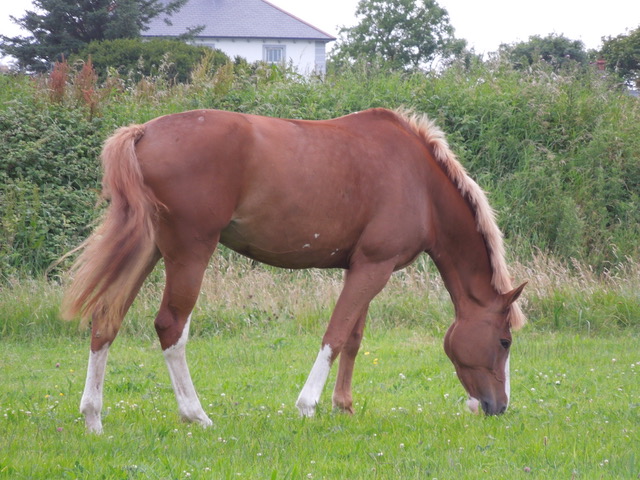
Goodbye again, Liscannor, even though I can barely see the magnificent Moy House across the lovely bay while we are shrouded in mist. The cows have been gone for a long time now. I will miss my herd, especially Elsie, the Queen of the Castle.
So long to the Hills of Kerry that I only just discovered are visible from our house. But only in certain light. They look like a soft blue cloud formation on the distant horizon.
Mia, the chestnut mare, was only here a very short time. She has three white socks. Three is good luck Elaine told me. Not two. Not one. Not four. Must be three.
This will be the summer remembered by all as the summer that wasn’t. Way too often, it was bitterly cold and windy. The great deluge produced a pond in the little depression by our stone wall. Next, I expected to see baby fish, begging me to rescue them.
One ferocious night, during a storm of biblical proportions, the waves were crashing ceaselessly on our shore. The violent rain hammered our house and sent a tsunami of salt spray clear over our chimney. But then, one fine day, the bay did dazzle me. A giant sparkling pavé diamond spread seductively all the way from the sandy beach of Lahinch to the mighty Atlantic Ocean. What a spectacular sight.
Goodbye again, my precious Liscannor.


